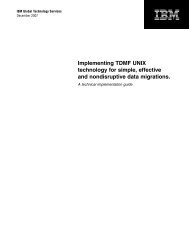Making Connections: Using SOA to enable collaboration in travel - IBM
Making Connections: Using SOA to enable collaboration in travel - IBM
Making Connections: Using SOA to enable collaboration in travel - IBM
You also want an ePaper? Increase the reach of your titles
YUMPU automatically turns print PDFs into web optimized ePapers that Google loves.
There is an impact on job schedul<strong>in</strong>g and<br />
network management. The event-driven nature<br />
of send<strong>in</strong>g this <strong>in</strong>formation often requires<br />
batch jobs <strong>to</strong> run aga<strong>in</strong>st the same database<br />
systems as used by onl<strong>in</strong>e applications,<br />
requir<strong>in</strong>g careful management of job execution<br />
<strong>to</strong> m<strong>in</strong>imize impact on onl<strong>in</strong>e system performance.<br />
Last, error handl<strong>in</strong>g for file transfer<br />
approaches is fraught with challenges <strong>in</strong><br />
problem identification, let alone address<strong>in</strong>g<br />
any issues. With an <strong>SOA</strong> <strong>in</strong>terface <strong>to</strong> send or<br />
push this data out, much of this can be elim<strong>in</strong>ated.<br />
For the dest<strong>in</strong>ation country, data is sent from<br />
multiple carriers at all times. These data files,<br />
regardless of how they are transported, require<br />
software jobs <strong>to</strong> load the data before the data<br />
can be used for any purpose. Depend<strong>in</strong>g<br />
upon the enterprise IT architecture and implementation,<br />
additional data management<br />
– movement or copy<strong>in</strong>g – may be needed<br />
<strong>to</strong> make the data available <strong>to</strong> the different<br />
analysis software that processes the data.<br />
These jobs take time – time that is not always<br />
as plentiful as needed. This data management<br />
also can be avoided.<br />
<strong>Us<strong>in</strong>g</strong> the <strong>SOA</strong> <strong>in</strong>terface shown <strong>in</strong> Figure 3, the<br />
data can be sent as the events (reservations,<br />
or flight closed for departure) occur directly<br />
<strong>in</strong><strong>to</strong> the dest<strong>in</strong>ation systems. The call-return<br />
nature of the <strong>SOA</strong> <strong>in</strong>terfaces, much like a telephone<br />
call, provides <strong>in</strong>stant verification <strong>to</strong> the<br />
airl<strong>in</strong>es that the data arrived and its status.<br />
To create the solution detailed <strong>in</strong> Figure 3, the<br />
dest<strong>in</strong>ation countries would build the layers of<br />
services <strong>to</strong> work with their exist<strong>in</strong>g systems.<br />
7 <strong>Mak<strong>in</strong>g</strong> connections<br />
The airl<strong>in</strong>e <strong>in</strong>formation services would be<br />
“exposed,” or made available, <strong>to</strong> the airl<strong>in</strong>e<br />
GDS and DCS systems. The data content<br />
would align with current Advance Passenger<br />
Information (API)standards. 5 With <strong>in</strong>dustry and<br />
government <strong>collaboration</strong>, standard service<br />
models could be established <strong>to</strong> allow any<br />
airl<strong>in</strong>e <strong>to</strong> <strong>in</strong>teract with any government implement<strong>in</strong>g<br />
the standard.<br />
<strong>SOA</strong> value: modularity and openness<br />
Shar<strong>in</strong>g passenger <strong>in</strong>formation <strong>in</strong> advance<br />
creates the potential for a number of benefits:<br />
• The measurable improvement over exist<strong>in</strong>g<br />
flight clearance time performance<br />
• The removal of low-risk passengers<br />
from primary <strong>in</strong>spection, allow<strong>in</strong>g limited<br />
resources <strong>to</strong> be used for higher-risk passengers<br />
• Improved cost efficiencies, achieved through<br />
reduced per-unit <strong>in</strong>spection costs and<br />
<strong>in</strong>creased facility throughput<br />
• Improved border control capabilities<br />
result<strong>in</strong>g from <strong>in</strong>creased <strong>in</strong>telligence and<br />
data collection opportunities<br />
• Lower costs associated with the removal of<br />
<strong>in</strong>admissible passengers<br />
• Easier, quicker <strong>travel</strong> for passengers.<br />
The advantage of <strong>SOA</strong> is its modularity and<br />
openness. New systems do not have <strong>to</strong> be<br />
“hard wired” <strong>to</strong> exist<strong>in</strong>g systems; the systems<br />
can exchange <strong>in</strong>formation through the <strong>SOA</strong><br />
services layer. Correspond<strong>in</strong>gly, a virtually<br />
limitless number of systems can connect –<br />
mean<strong>in</strong>g that the <strong>travel</strong> systems of any country<br />
6

















